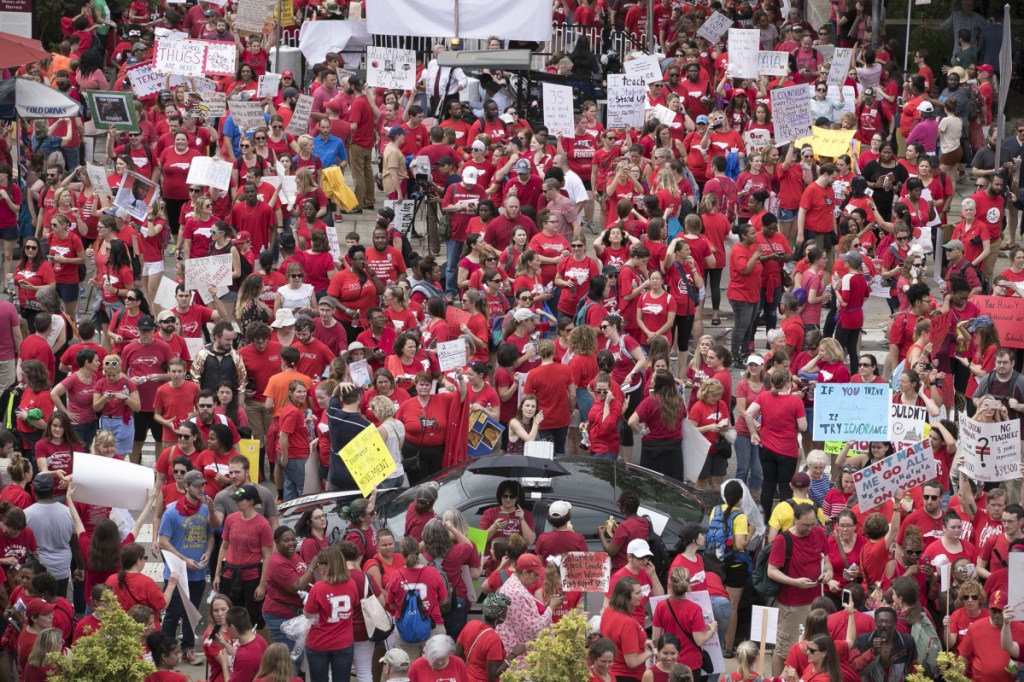WASHINGTON — When teachers in several U.S. states walked out of their classrooms this year to protest stagnant pay and school funding, they struck a chord with the public.
Now they’re battling to turn that sympathy into gains at the ballot box – and Democrats are hoping that a wave of teacher candidates will help them flip control of statehouses and governorships.
More than 1,400 current or former education workers are contesting state seats in Nov. 6 elections, according to the National Education Association, the largest U.S. union. More than 1,000 of them are Democrats – accounting for 19 percent of the party’s candidates in state elections.
“People are woke,” said Lily Eskelsen Garcia, the NEA’s president. “You bet that’s going to make a difference.”
HOLDING STRONG
The wave of school unrest began in February in West Virginia, where a “wildcat” walkout eventually won a 5 percent raise for state employees. Similar stoppages followed in states from Arizona to North Carolina. More than three-quarters of parents with children in public schools said they would back local teachers if they joined the strike bandwagon, according to a national survey in May commissioned by education group PDK International.
The sentiment won’t swing races everywhere, with education just one of many election issues (though several state-level polls show it’s at, or near, the top of voter concerns). But it can make a difference in tight races — and help turn some contests that shouldn’t normally be close into nail-biters.
Deep-red Oklahoma is a good example. In the race to be governor, Republican businessman Kevin Stitt has a surprisingly narrow single-digit polling lead over his Democratic opponent Drew Edmondson, a former teacher and attorney general.
Edmondson spent the summer holding listening sessions with teachers, and he’s promising to shrink class sizes and boost pay. Oklahoma’s teacher strike was key in making that a viable strategy and giving the Democrat a chance of an upset win, according to University of Oklahoma political scientist Keith Gaddie.
Gaddie recalls stopping at gas stations during this year’s strike and seeing teachers approached by strangers who offered to buy them fuel or coffee. He points out that many of the strikers’ most vocal critics, “the worst of the anti-education lawmakers in the GOP,” got beaten by primary challengers.
After Oklahoma’s teachers announced a strike date, the state’s Republican-controlled Legislature approved its first tax increase in decades in order to fund schools. That measure has given Republican candidates a strong case to make to voters, in a state where “everybody agrees we need to do more for education,” says Chad Alexander, former Republican chairman in Oklahoma.
Nationwide, state governments haven’t been doing much. Their finances took a hit during the Great Recession, but as the economy rebounded, their spending on elementary and secondary education hasn’t kept pace.
It was $625 billion in 2016, according to the U.S. Census Bureau’s survey of state government finances. That was 3.3 percent of America’s GDP – down from 3.8 percent in 2010, the year Republicans won a midterm landslide that gave them control of several statehouses. Capital outlays for schools dropped in plain dollar terms, even before adjusting for inflation and population growth.
‘POWER IN NUMBERS’
“In the recovery, when revenues were coming back, they didn’t add education spending to make up for the prior cutbacks,” said Lawrence Mishel, an economist at the progressive Economic Policy Institute in Washington. The result has been “severe cuts in per-pupil spending,” he said. “It’s not a situation where someone is trimming some fat in the budget. They were really way into the bone.”
The cuts also hurt public school teachers, who earn 19 percent less than other workers with similar education and experience, according to the EPI. The gap has ballooned from less than 2 percent in the mid-1990s.
Angry teachers have caused turmoil in both parties in recent years. A fractious dispute with the Chicago Teachers Union helped catalyze opposition to Mayor Rahm Emanuel, who was forced into a runoff in 2015 and in September announced he won’t seek re-election next year.
In May, the Republican majority leader of Kentucky’s House, who had advocated cutting teachers’ pensions, lost his primary to a high school math teacher who had never run for office before.
Democrats have nominated ex-teachers as governor candidates in Arizona, Minnesota and Wisconsin. In the latter, state superintendent of public instruction Tony Evers is facing off against Republican incumbent Scott Walker, a trailblazer for cutting spending and curbing unions. Debate over who can be trusted to adequately fund schools is a major flashpoint in the race.
Lower down the ballot are hundreds of teachers like Brianne Solomon, an American Federation of Teachers member who chairs a high school fine art department in West Virginia.
“Every January, when our Legislature goes into session, I had this ball of nervous energy, anxiety” about what they might do to teachers, said Solomon, a first-time Democratic candidate for the state Legislature. She says the strike – which she took part in – has boosted her campaign.
“We realized we do have power in numbers,” she said. “We shocked ourselves.”
Send questions/comments to the editors.


